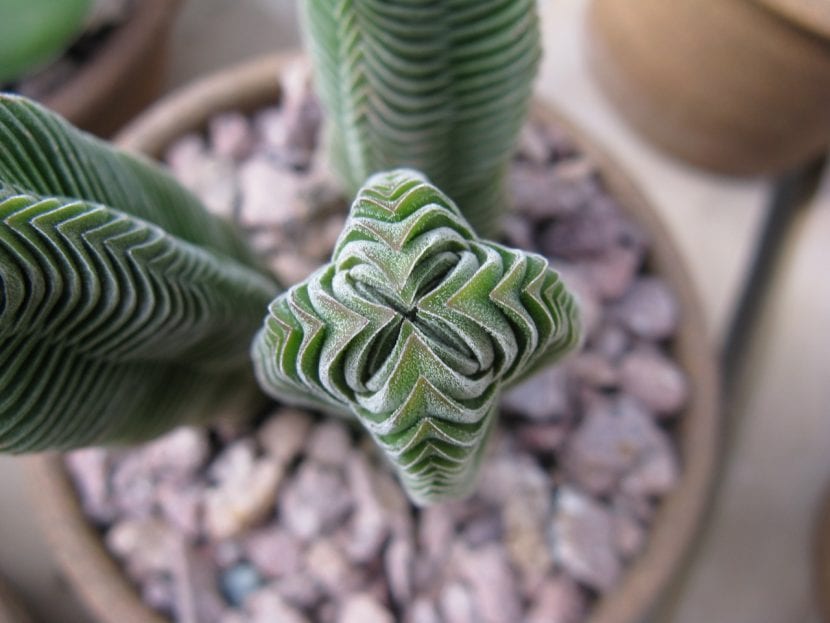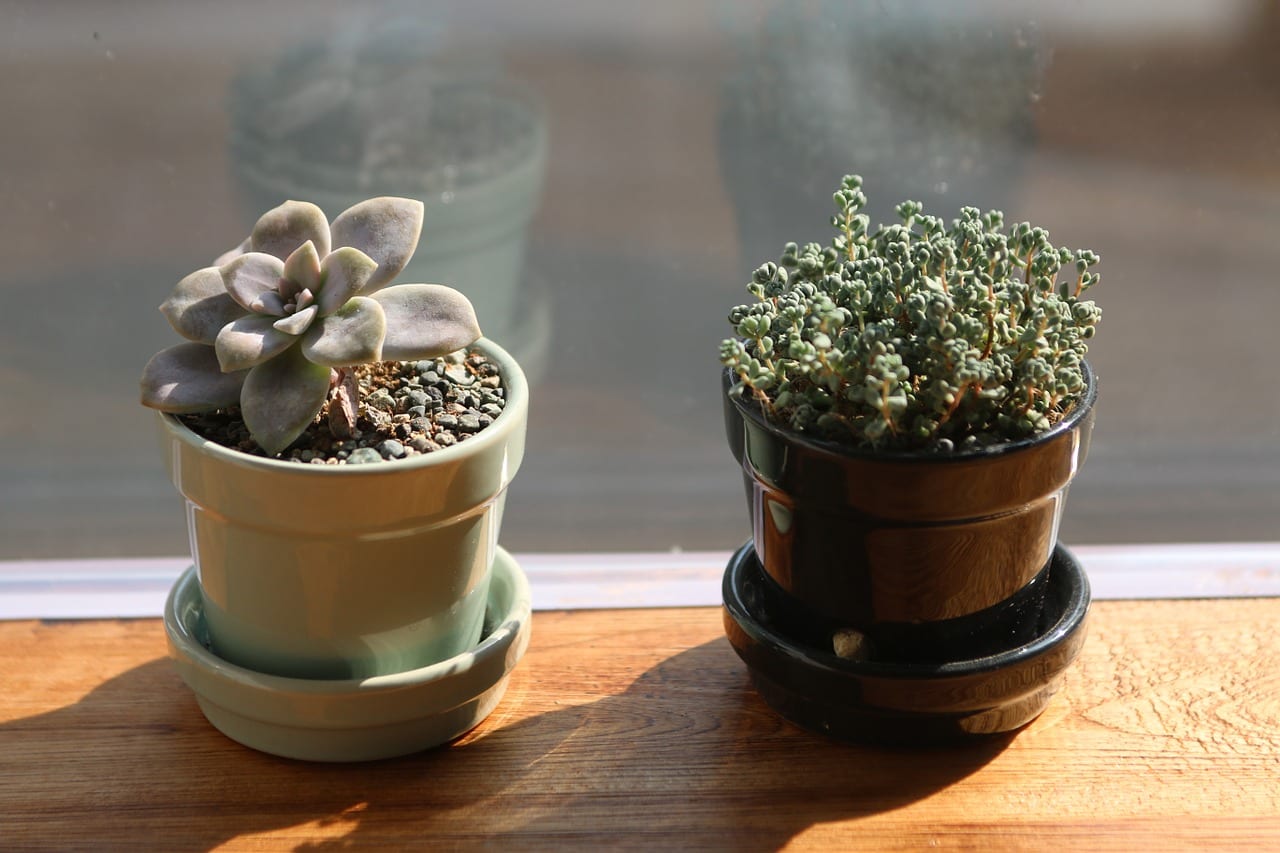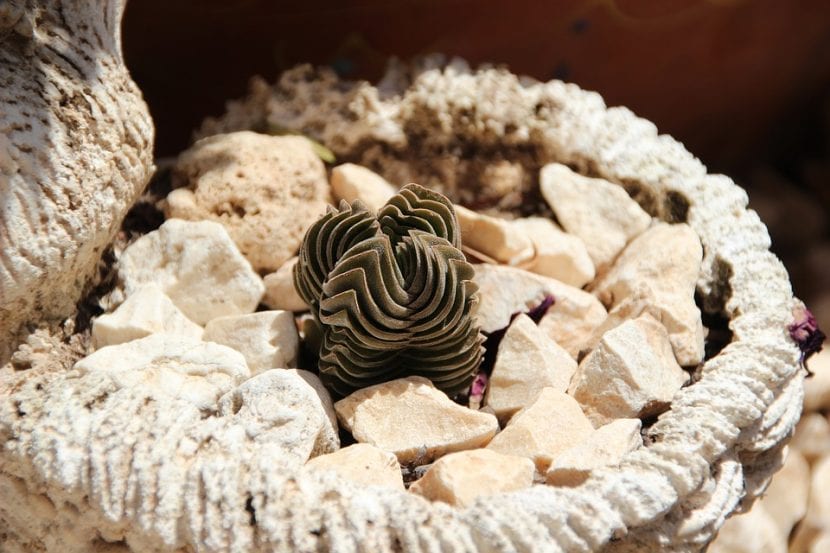
Image - worldofsucculents.com
La Crassula Buddha Temple It is an ideal succulent plant to decorate the interior of the home, or to have in the collection of succulents. It reaches a height of about 15cm, so it can live throughout its life in a pot.
But What care does this strange and beautiful plant require? It is not easy to find it in nurseries, and when you finally get it, you may have many doubts about watering, location and / or compost. If that has happened to you, don't worry. Follow our advice and you will see how your Buddha Temple will grow wonderfully.
Characteristics of the Crassula Buddha Temple

Our protagonist is a plant that was obtained by crossing the Crassula pyramidalis with the Crassula perfoliata var. minor. It is known by the name of Crasula Temple of Buddha or, in English, Crassula 'Buddha's Temple', and is that its appearance is very reminiscent of Buddhist temples.
It is characterized by having a geometric shape, stacking its four leaves in the shape of a cross. Over time, it tends to produce suckers, which can be separated and planted in other pots. It reaches a maximum height of about 15 centimeters. The flowers are very tiny, pinkish-white, and sprout at the top of each stem.
How do you take care of yourself?
If you want to have one or more copies, here is how to take care of it:
Location
It is a non-cactus succulent that can be both outdoors in full sun and indoors in a room with plenty of natural light. In any case, it is important that you know that if they had it in a protected area and you want to put it in an exposed area, you should get used to it little by little and gradually.
Substratum
Must have very good drainage. You can mix equal parts universal growing medium with perlite, or choose to plant it in pomx or river sand. It is a plant that fears waterlogging, and does not like the soil to compact (which can happen to black peat).

For this reason, in addition, it is not advisable to plant it in the garden, unless you have a porous soil capable of absorbing and draining water quickly.
Irrigation
Rather little. It is necessary to water only when the substrate is completely dry. During the winter, it is advisable to water every 15 or 20 days, and the rest of the year once or twice a week.
Subscriber

Image - Cactusplaza.com
Not only is water vital to the Crasula Buddha Temple, so is 'food'. During spring and summer it should be paid with a mineral fertilizer for cacti and succulents following the instructions specified on the package. Of these fertilizers you will see that they are sold in liquid format and in granules. The former are more suitable for potted plants, since they do not interfere at all with the drainage capacity of the substrate; on the other hand, the granules are more advisable for those that are in the garden.
You can get a liquid succulent compost here and one granulated here.
Transplant
Every two years, in spring. Once it reaches its final size, it can be left in the same pot as long as it is fertilized regularly; otherwise you will need new substrate every 2-3 years.
Multiplication
La Crassula Buddha Temple multiplies only by suckers in spring or summer, because it does not produce seeds. The way to proceed is as follows:
- First, you have to wait for the youngster to reach a size that allows you to handle it easily.
- Then, separate it from the mother plant with the help of a previously disinfected knife or scissors -also disinfected-.
- Afterwards, let the sucker's wound dry for a week, placing it in an area protected from the sun and rain.
- After that time, impregnate its base with homemade rooting agents and plant it in a pot with pumice, akadama or similar.
- Finally, place the pot outside, in semi-shade.
Keeping the substrate moist (but not waterlogged), it will emit roots in about 15 days.
Plagues and diseases
En general, it is quite resistant. However, if the care or the climate is not the most suitable, it can be affected by mealybugs if the environment is very dry and warm, or by fungi if, on the contrary, it is very humid or is being watered excessively.
With regard to the first, you can remove them with a brush or if you prefer with potassium soap or diatomaceous earth, but in cases of excess watering or high humidity it is very important that the substrate has excellent drainage and that it is watered little. If you live in an area where it rains frequently, keep it indoors in a bright room without drafts. Also do preventive treatments with fungicide.
Rusticity
Withstands frosts down to -2ºC provided they are punctual and short-lived, although it lives better in hot climates with temperatures above 0 degrees.
Where to buy the Crassula Buddha Temple?

It is a crass that they sell in nurseries, garden stores and specialized sites.
Enjoy it 🙂.
With reference to the crass Buddha temple, I have a problem: after a long time of trying to finally obtain it at the garden center that I usually do my shopping they got me; But the problem is that for two consecutive times on the first day of buying them I have left them at night in the greenhouse (semi open) where I have my collection, and the rats have eaten them. I have more than 50 different succulents and the only one they eat is the Buddha temple. Can someone explain to me why?
Hi Catalina.
It is curious what you comment. They may just like the taste.
You can protect it with a grid (metallic cloth). Or, if you like cats and you can take care of one, adopt a furry 🙂
A greeting.
I have one that I got 5 months ago, it came green, but over time the leaves turn ocher or dark yellowish, and wrinkled, some tell me that it is because of a lot of water, others tell me that it is because of a lot of sun burned, I do a deep riwego every 15 days and I keep it in the shade in the hours of full sun such as midday, I no longer know what to do. What I noticed as soon as the seller brought it to me is that the plant if you like the pot moved, as if it were not well rooted. Would someone tell me what to do?